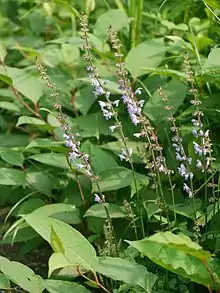Salvia japonica
Salvia japonica, known as East Asian sage,[1] is an annual plant that is native to several provinces in China and Taiwan, growing at 200 to 1,200 m (660 to 3,940 ft) elevation. S. japonica grows on erect stems to 40 to 60 cm (16 to 24 in) tall. Inflorescences are 2-6 flowered verticillasters in terminal racemes or panicles, with a corolla that varies in color from reddish, purplish, bluish, to white, and is approximately 1.2 cm (0.47 in).
| Salvia japonica | |
|---|---|
 | |
| Scientific classification | |
| Kingdom: | Plantae |
| Clade: | Tracheophytes |
| Clade: | Angiosperms |
| Clade: | Eudicots |
| Clade: | Asterids |
| Order: | Lamiales |
| Family: | Lamiaceae |
| Genus: | Salvia |
| Species: | S. japonica |
| Binomial name | |
| Salvia japonica | |
| Varieties | |
| |
There are two named varieties, with slight variations in leaf and flower shape: S. japonica var. japonica and S. japonica var. multifoliolata[2]
References
- English Names for Korean Native Plants (PDF). Pocheon: Korea National Arboretum. 2015. p. 619. ISBN 978-89-97450-98-5. Archived from the original (PDF) on 25 May 2017. Retrieved 4 January 2017 – via Korea Forest Service.
- "Lamiaceae" (PDF). Flora of China. Harvard University. 17: 171. 1994. Archived from the original (PDF) on 2010-07-14.
External links
This article is issued from Wikipedia. The text is licensed under Creative Commons - Attribution - Sharealike. Additional terms may apply for the media files.